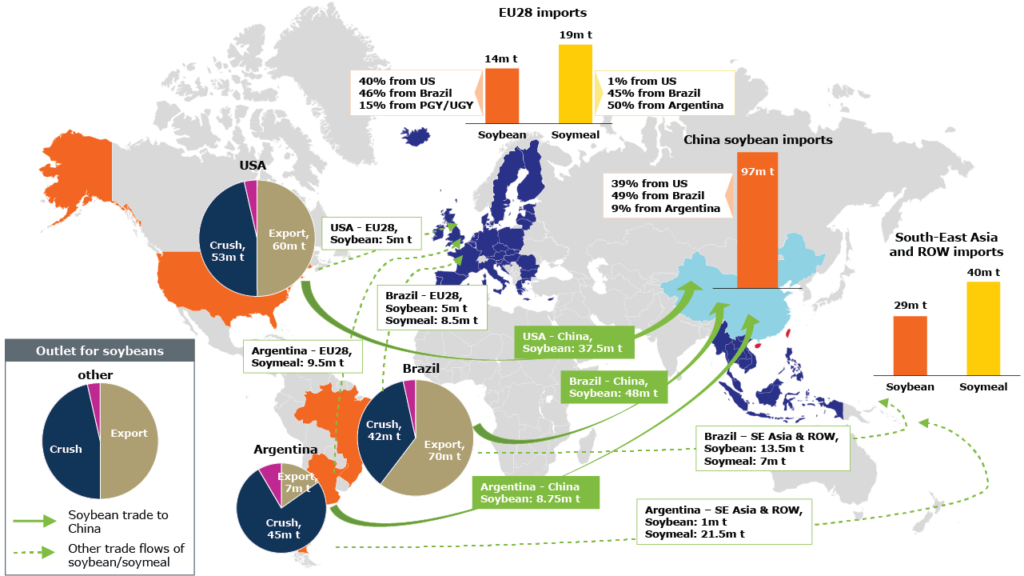Soybean (Glycine max, L) is an annual crop that belongs to the Fabaceae or Leguminosae family. It originated from East Asia but is now being grown over a wide geographical area worldwide. Countries such as America, Brazil, China, and Argentina are leading soybean producers. beans can be used in food products (e.g., tofu, soybean sauce), as edible vegetable oil and biofuel. Not only is soybean is used as a source of high-quality edible oil in the human diet, but also as a high-quality vegetable protein in animal feed worldwide. The surge in the use of soybean meal in feeding animal as substitute protein source for animal protein feeds is the main driving force in soybean production. The universal acceptability of soybean in animal feed is due to several favourable attributes such as relatively high protein content and suitable amino acid profile (with the exception of methionine), minimal variation in nutrient content, ready availability year-round, and relative liberty from intractable anti-nutritive factors if properly processed. Additionally, attention has been focused on soybean utilisation as an alternative protein source in animal diets due to either the changing availability or permitted uses of animal proteins coupled with relatively low cost (Dei, 2011).
The EU imports both soya beans and soya bean meal for compound feedstuffs production for young animal production, poultry, and pigs. Figure 1 illustrates that Brazil and Argentina are the largest regions of origin for soybean imported by Europe. However, growing and exporting soybean has generated environmental impacts such as deforestation and grassland conversion which poses a severe threat to ecosystems in exporting countries. Yet, the effect of deforestation is mostly indirect. The main direct driver for deforestation is cattle ranching; approximately 80% of newly deforested land in Brazil is used for ranching. The development of soybean cultivation land happens mostly in pastures, therefore displacing cattle ranching in to forest areas and the savannah. In more recent years, soybean cultivation also shifted to formerly uncultivated ecosystems which has led to direct deforestation. Hence, the surge in soybean cultivation in Brazil and Argentina is somewhat at the cost of other arable crops and grasslands but also connected to the loss of forest and savannah (Boerema et al., 2016).
Figure 1: Argentina and Brazil exportation of soy to Europe

Increasing soybean import by European countries is also changing land use in Europe. The meat consumption and livestock sector in Europe shifted to less cattle and sheep and more pigs and poultry. This is primarily due to pig and poultry meat being cheaper since less land use is needed to feed the animals and is coupled with cheap protein-rich feed products. For cattle production itself, a shift towards less grazing and more alternative feed like cereals and protein-rich products is being observed. The increasing soybean imports to Europe from both countries clearly demonstrates the increasing consumption of protein-rich products by pigs, poultry, and cattle. Hence, it is anticipated that the increasing soybean import will cause a decrease of permanent meadows and pastures and an increase of maize and other cereal production for animal feed (Boerema et al., 2016).
Since Europe is so far highly dependent on protein importations, there are several factors may lead to an increased soybean production within the EU over the coming years. Among the several reasons for such an increase are societal contemplations such as carbon footprint of imported soybean, development of market niches, entrance of new European Union Member States that have a history of soybean cropping as well as a general increase of American exports toward China inducing pressures on prices particularly for poultry and pig feeding. Soybean cropping would however probably be considered as an opportunistic European crop due to e.g., rotation for combatting wheat rootworm which is prevalent in Central and Eastern EU and is spreading into the Western area, continuous rises in nitrogen fertilizer prices, a persistent ban of meat-and-bones meal as well as an absence of alternative European protein-rich crops (Bertheau and Davison, 2011).
References
BERTHEAU, Y. & DAVISON, J. 2011. Soybean in the European Union, status and perspective. InTech-Open Access Publisher.
BOEREMA, A., PEETERS, A., SWOLFS, S., VANDEVENNE, F., JACOBS, S., STAES, J. & MEIRE, P. 2016. Soybean Trade: Balancing Environmental and Socio-Economic Impacts of an Intercontinental Market. PLoS One, 11, e0155222.
DEI, H. 2011. Soybean as a Feed Ingredient for Livestock and Poultry.